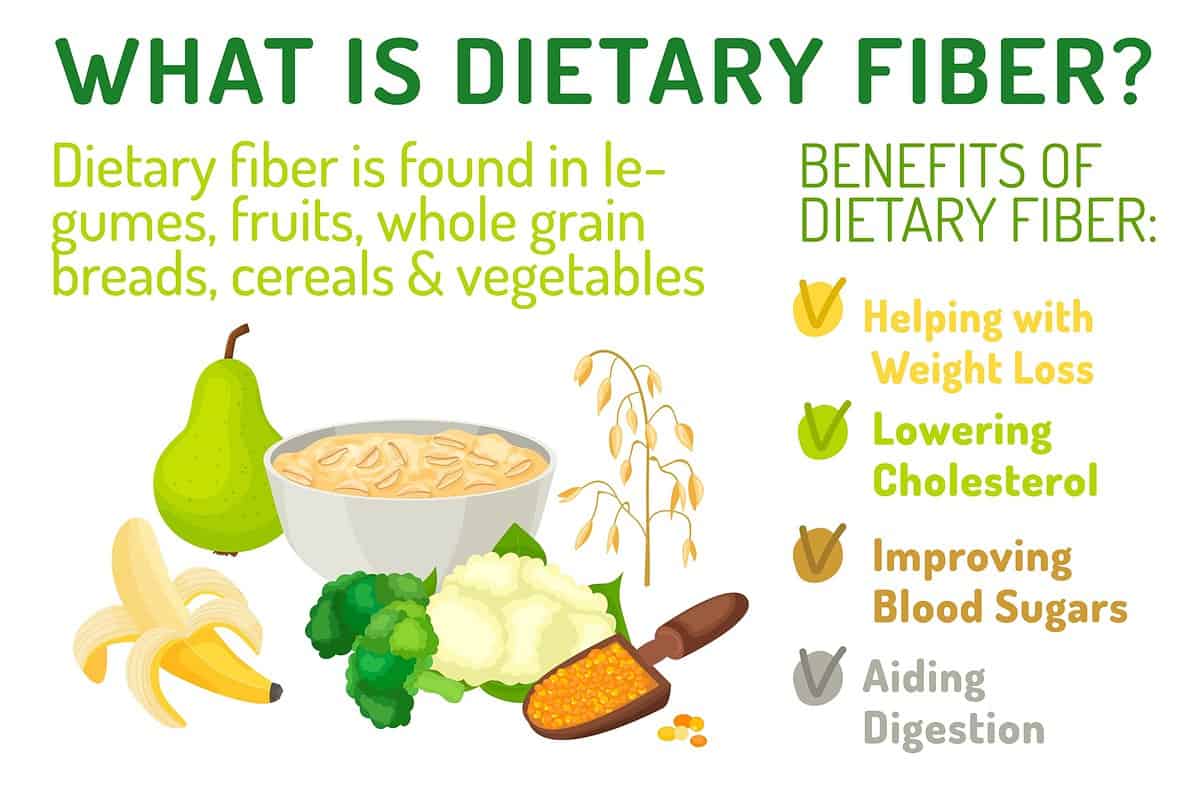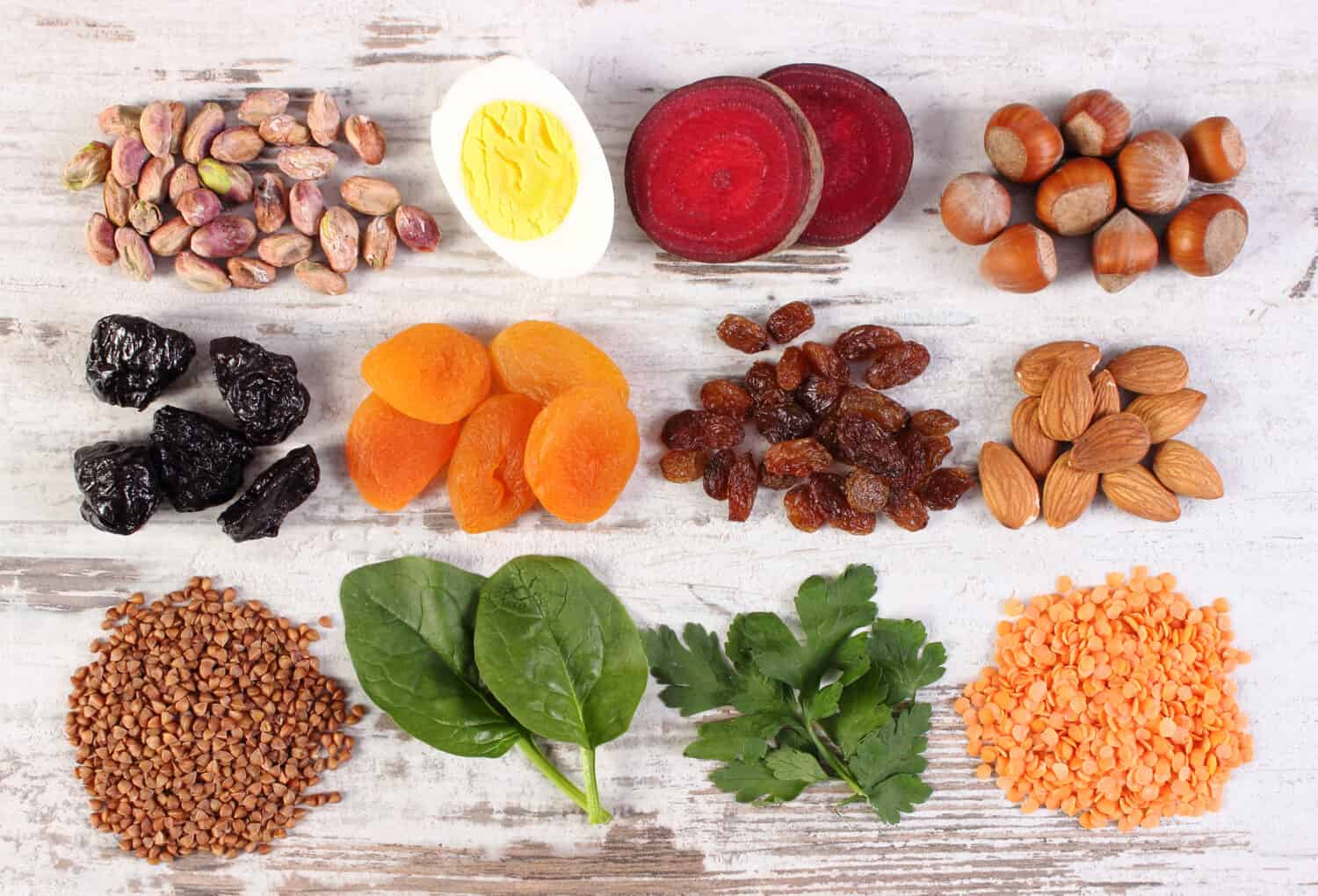Dietary fibers are substances in plant-based foods that pass through the alimentary canal without digestion. It is also called roughage or bulk. Unlike other nutrients such as carbohydrates, fats, and proteins, dietary fiber cannot be broken down or absorbed by the body.
Dietary fibers are grouped generally by viscosity, fermentability, and solubility, which predominantly affects how they are processed in the body. They are formed by many compounds in foods such as fruits, beans, wholegrain, pulses, and vegetables. Dietary fibers are generally divided into 2, i.e., soluble and insoluble, which are both essential and need to be included in our daily diet, as we shall see later in this post.
In this article, we’ll dive deeper into dietary fiber, what it is, its benefits to the body, and how to get more of it, among other key points.

©Double Brain/Shutterstock.com
What is Dietary Fiber?
Maintaining a healthy diet requires consuming an adequate amount of dietary fiber – although not all fibers are created equal. There exist two primary types: soluble and insoluble dietary fibers, each possessing distinct benefits for your well-being. Soluble dietary fibers lower inflammation rates; they regulate blood sugar levels as well as decrease cholesterol levels, while insoluble fibers foster digestion by promoting bulk-creation and sustaining digestive wellness.
It's essential also to understand some other forms of dietary fiber, such as prebiotic fiber; useful bacteria feed on these within the intestines so your body can process food efficiently for optimal nutrient extraction purposes. Additionally, there is resistant starch that passes through the gut unchanged.
While planning your meal consumption pattern, always remember foods such as oatmeal, apples, and beans play host to significant soluble fibers, whole-wheat bread, brown rice, and whole grains conserve the most insoluble dietary fiber. In general, your body needs dietary fiber; whichever type of fiber you consume equally contains its health benefit.
If you're in good health, a good rule of thumb is to not be too worried about what type of dietary fiber you consume. It is important to note that soluble fibers such as psyllium husks or guar gum may have limited digestibility. Combining them with other soluble fiber sources like oat bran or flaxseeds when consuming assists in absorption and an overall healthy metabolism process.
Groups of Dietary Fiber
Non-starch long carbohydrates constitute the larger group of fibers found in varying concentrations. They are primarily found in some parts of foods like whole grains, pulses, nuts, beans, fruits, and vegetables.
Resistant carbohydrates – These are complex carbohydrates that require high levels of energy generated by the body to digest them. They are highly nutritious and can be found in beans, oats, plantains, potatoes, cashew nuts, and lentils. Resistant carbohydrates are a form of starch that the small intestine cannot digest. Alternatively, healthy bacteria present in the intestines are responsible for digesting them.
Lignin plays a significant role as a component of dietary fiber. It is highly resistant to enzymatic and bacterial breakdown in the small intestines, which are finally expelled through feces. It is found in root tubers such as carrots, turnips, nuts, and seeds.
Sources
Incorporating more dietary fiber in your diet can offer a variety of health benefits and can help you achieve your weight loss goals, and keep your gut healthy. The best way to get more dietary fiber is to incorporate high-fiber foods into your meals and snacks. There are many healthy high-fiber foods that you can add to your diet, including

Sources of fiber are common, everyday foods all around us!
©ratmaner/Shutterstock.com
- Wholemeal
- Whole fruit
- Vegetable
- Legume
- Nut
- Whole grains
- Seeds
Adding these foods to each meal will give you an extra boost of dietary fiber that will leave you feeling full for longer and help promote healthy weight loss and a healthy digestive tract.
Types of Dietary Fiber Supplements
Dietary fiber supplements are a convenient way to increase your fiber intake, especially if you struggle to consume enough fiber through your regular diet. There are several types of dietary fiber supplements available on the market, including:
Psyllium husk is a popular supplement produced from the plant's seeds known as Plantago ovata. It belongs to the soluble fiber group, which forms a gel-like substance when mixed in water. It promotes frequent bowel movements and generally supports digestive health.
Inulin is a soluble fiber supplement in many vegetables and fruits, like bananas, onions, and asparagus. It is also available as a dietary fiber supplement. It acts as a prebiotic, producing healthy bacteria for your gut and helping promote a healthy digestive system.
Methylcellulose is a synthetic fiber commonly used as a bulking agent in fiber supplements. It absorbs water and swells in the intestine, adding bulk to the stool and promoting regular bowel movements.
Cellulose is an insoluble fiber found in the cell walls of plants. It adds bulk to the stool, helping to promote regular bowel movements. Cellulose is often derived from plant sources like wood pulp or cottonseed and is often available as a fiber supplement.
Health Benefits of Dietary Fiber
Dietary fiber is an essential nutrient for the human body that has many health benefits.
Here are some of them:
Bowel movement regulation
Dietary fiber helps increase the size and weight and soften your stool. Fiber helps to solidify watery stools as it absorbs water and increases the bulkiness of the stool. A bulky stool is easier to release, lowering your chances of being constipated.
It helps improve bowel movement
Whether you are experiencing loose or hard stool, fiber helps provide consistency. Fiber maintains water if the stool is too hard, making it softer and relieving constipation. On the other hand, if the stool is too weak, fiber helps in adding to the bulk, giving it form and shape.
Management of cholesterol levels
Consumption of soluble fiber will help in lowering cholesterol levels. These fibers attach themselves to cholesterol in the small intestines, preventing the body from reabsorbing it into the bloodstream, thereby being expelled from the body as stool.

Consuming enough fiber daily helps keep gut health in check and avoid constipation.
©iStock.com/TanyaLovus
Regulation of blood sugar levels
It is worth noting that fiber does not affect glucose levels in the body, which is a good reason why we should include it in our meals. It is good at balancing blood sugar levels simply because the body does not need insulin to break down fiber. This is because the body cannot digest fiber.
Aids in achieving healthy body weight
Foods that are high in fiber content help in promoting weight loss because of their filling ability while also, at the same time, being low in calorie content. The more you eat, the less room you have left to accommodate less dense nutrient-rich food. Soluble fiber keeps bacteria in the gut healthy and promotes overall fat loss by reducing your appetite. Soluble fiber intake can complement other uncompromising lifestyle changes like regular exercise and more nutritious food choices.
Increase in life expectancy
Fiber is a significant player in promoting youthfulness. According to studies, older people who eat fiber-rich foods are likelier to stay healthier and live longer than those who don't. They lower the risk of coronary heart disease, obesity, premature deaths, and some forms of cancer.
Studies have shown that if you increase your cereal fiber intake, you are reducing the chances to succumb from cardiovascular diseases. Studies have also shown that the bulk fiber that travels through the colon traps the bile acids and carcinogenic substances, reducing the risk of getting pancreatic and colorectal cancer.
Promotes gut health
Recent studies have shown that fiber consumption directly impacts the intestines' bacteria composition. The gut produces fatty acids, which help improve the immune system's daily functioning and generally regulate the body's energy balance.
Dental hygiene
Foods with high fiber content are beneficial for oral hygiene. The chewing process of high-fibered foods triggers an increase in saliva production, thus stimulating natural cleansing action and adequate blood flow to the teeth and gums. Also, with the anti-bacterial property in saliva, more production boosts dental hygiene. Some high-fibred foods also contain substances that inhibit the growth of oral bacteria.
Daily recommended fiber intake
You can consult a healthcare professional or licensed dietitian to determine the appropriate fiber intake for your specific circumstances. Additionally, it's recommended to increase fiber intake gradually to avoid digestive discomfort and to consume a variety of high-fiber foods for overall health and nutrient balance
Here are the general guidelines for daily fiber intake according to the Institute of Medicine:
| DESCRIPTION | AGE | GRAMS PER DAY |
| Adult men | 51 years and above | 30 grams |
| Adult women | 51 years and above | 21 grams |
| Pregnant women | 28 grams | |
| Breastfeeding women | 29 grams | |
| Adult women | 19 to 50 years | 25 grams |
| Adult men | 19 to 50 | 38 grams |
How Much Fiber Should My Children Eat?
At every stage in your child's life, offering nutritious food always plays an important role in keeping them healthy and strong. Fiber has become an essential part since it promotes good digestion and helps control blood sugar levels.
In order to fulfill the desired balance, kids between the ages of 1 and 3 should consume 19 grams of dietary fiber, 4 to 8-year-old children should have an intake of around 25 grams, while those between 9 and 13 must absorb an intake of almost 28 grams. Finally, adolescents 15 and above are required to have at least 30 grams in a day for optimal health outcomes that will keep them boosted.
Lastly, incorporating fruits and vegetables while making up their diet is fine, but leveraging diverse sources like whole grains & legumes can further enhance the fiber content they so need.
Potential Risks and Complications of a Low-Fiber Diet
People relying on a low-fiber diet face numerous adverse outcomes that could lead to complications, such as constipation, abdominal distress, bloating, or insufficient nutrient assimilation. To be specific, the formation of rectal pockets (diverticula) that can cause pain (diverticulitis), and inactivity due to excessive bowel movements (irritable bowel syndrome) could be some problems associated with this irregular way of consuming food material.
Studies show that diets with fewer fibers increase the probability of having chronic illnesses such as coronary disorders or diabetes. This is because they influence two vital determinants – blood sugar level and cholesterol levels in an adverse way.
Considering these hazardous effects beforehand is important before making any adverse changes to one's dietary habits.
Essential Tips on How to Increase Fiber Intake
Having looked at dietary fiber, what it is, and its impact on your gut and general health, let's look at simple ways you can incorporate dietary fiber into your diet. Always be sure to consult with your doctor before making any changes to your diet and overall lifestyle:
- Start your day off by choosing breakfast cereal that is rich in fiber. Preferably five or more grams of fiber per serving. You can go for grains that are named “bran,” “whole grain,” or “fiber.”
- You can look for brands of bread listed as whole wheat, flour with whole wheat, or whole grain as the active ingredient.
- Depend on legumes as the primary sources of fiber. These are mainly peas, beans, and lentils, which are excellent sources of fiber.
- Your intake of fruits and vegetables that are rich in fiber does not need to be regulated; this also counts for vitamins and minerals. You are allowed to eat at least five servings or more every day.
- Choose high-fiber snacks like raw vegetables, fresh fruits, wholegrain crackers, and low-fat popcorn, which are all perfect choices for a snack. You can also opt to have nuts or dried fruits, which are fiber-rich. But note that while nuts are very nutritious, they are high in calories, so a handful per serving would be highly recommended.

A yummy salad is one easy way to incorporate fiber into your diet.
©Marian Weyo/Shutterstock.com
Conclusion
Adding too much fiber all at once can cause intestinal gas, abdominal bloating, and cramping. You are required to increase your fiber intake over a few weeks gradually. By doing this, your digestive system will adjust to the change with the help of natural bacteria.
When selecting which fiber supplement is good, reading through the product labels and following the dosage instructions is vital. Additionally, drinking adequate amounts of water when taking fiber supplements is essential to prevent potential digestive discomfort.
Remember, while supplements can help meet specific dietary needs, fiber works best when it absorbs water. Be sure to drink enough water daily to make your stool soft and bulky.
The image featured at the top of this post is ©Antonina Vlasova/Shutterstock.com

